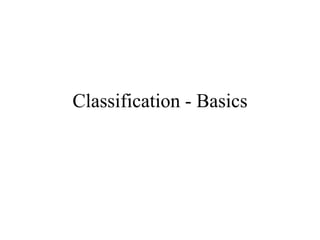
Classification - Basics.ppt
- 2. What is Classification ? • Classification in Sense 1 – Division • Classification in Sense 2 – Assortment (it is inherent in Man) • Classification in Sense 3 – Sense 2 + Representing each entity by an ordinal number taken out of a system of ordinal numbers, designed to mechanise the maintenance of the sequence
- 3. • Classification in Sense 4 – Sense 3 when complete assortment is made of an amplified universe– that is when the entities and the pseudo-entities arising in the process of successive assortment stand • Classification in Sense 5 – Sense 4 with all the entities removed but only the pseudo-entities or classes retained—each class having the number representing it
- 5. Classification Work • Idea Plane • Verbal Plane • Notational Plane
- 6. Need for Organising • “Knowledge explosion" - "information explosion" - "information flood" - "information boom ….. • Documents in various languages • Documents in diverse physical forms. • Abstractness of the entities- Nature and complexity of the thought content of the subject matter • The complexity of readers' approach to documents and libraries.
- 7. Document- embodied knowledge • Knowledge if intangible and experienced ONLY by its many manifestations. • A Matching between Manifestations of knowledge Manifestations of the Information Needs will ensures right service to users
- 8. Features of knowledge • VAST/HUGE • Dynamic – Change is the ONLY permanent feature! • Multidimensional • Heterogeneous • Continuity • Ambiguous • Multilingual
- 9. • Features of knowledge has implications on distribution and formation of new subjects • A Classificationist Maps this distribution and revise this mapping consistently with the developments in “Universe of Knowledge”
- 10. Maximum use of documents through: • Personal assistance to readers, • Systematic arrangement, and • Proper display of materials in the library.
- 11. Arrangement Done based on both extrinsic and intrinsic nature of documents • Age of reader • Conditions attached to the use of the material • Documents of unusual size: • Documents of unusual gross body: Micro cards, gramophone records, tapes, slides, and other audio-visual material and electronic documents are shelved separately. • Language of the document: • Value of the document: Manuscripts • Peculiarities of form of presentation: bound periodicals
- 12. • Date of printing: Incunabula • Local history collection • Gift collection • Colour • Volumes • Binding • Year of publication • Fixed position- accession no. • Thought content of the document (subject matter) • Author/ creator • Nature of information
- 13. User Approaches • Author approach: Generally readers go to a library to find: – i) a particular document whose author is known or – ii) what documents by a particular author are in the library. Marston, Elizabeth : Rain Forest Marston, John : Dutch Courtesan Marston, J.E. : Nature of Public Relations Marston, Phillip :Breeder of Democracy Marston, P.B. :Collected Poems Marst, R.M. : Electronic Projects
- 14. • Title approach – – Sometimes misquoted – Change from one edition to another. – Translated title changes – Different countries -different titles, though the language may remain the same. Instant Astrology by Jack London Instant Beauty Tricks by P. Brooks Instant Book Keeping by D.C. Conaway Instant Chicago by J. Graham
- 15. • Subject approach - majority of readers’ approach
- 16. Subject arrangement • Filiatory sequence- APUPA arrangement • Helpful sequence U M B R A P E N U M B R A P E N U M B R A A L E I N S A L E I N S A P U P A Subject Interest of User
- 17. Species of Classification Broadly speaking two species of classification systems - enumerative and faceted. • Fully Enumerative classification – Library of Congress Classification (LCC) , Rider's International Classification (RIC) • Almost Enumerative classification – Subject Classification of Brown and Dewey Decimal Classification (DDC) • Almost-Faceted classification – Universal Decimal Classification (UDC) and Bibliographic Classification of Bliss (BC) • Rigidly-Faceted classification – first three editions of Colon Classification (CC) • Freely Faceted classification – editions 4, 5, 6,7 of CC
- 18. Glossary • Entity – "Any existent, concrete or conceptual -that is, a thing or an idea" example: A boy, A book, Sweetness, A system of philosophy, A subject of study". • Attribute - Attribute is any property or quantitative measure or quality possessed by or inherent in an entity. • Characteristic - "an attribute, with reference to which the likeness or unlikeness of entities can be determined such that at least two of them are unlike".
- 19. Glossary • Discipline- is a major continuous area, of knowledge formed on the basis of either the similarity of the objects of study (i.e., whether natural objectives, or social issues); or, obtained by a similar mode of study or method of acquiring knowledge (i.e., whether imaginative, or empirical). – Sciences (study of natural objects) – Social Sciences (problems of society) – Humanities (by imagination/perceptions)
- 20. Glossary • Disciplines are further divided into basic subjects or main classes. A main class is, conventional but very cohesive area of knowledge. • A traditional subdivision of an old main class is known as a Canonical Class. algebra, geometry, analysis…. are canonical classes of the main class mathematics.
- 21. Glossary • Isolate- A solitary, unattached idea, which cannot be further, subdivided, and by itself it cannot form a subject. Isolates are arranged in what are called arrays and chains. • An array is a sequence of coordinate (equally ranked) classes arranged in some definite order. • A chain is a sequence of subordinate classes arranged in some definite order.
- 22. Reference • Prolegomena to Library Classification – S.R. Ranganathan • Library Classification – A.K. Ohdedar, B. Sengupta • Philosophy of Library Classification – S.R. Ranganathan